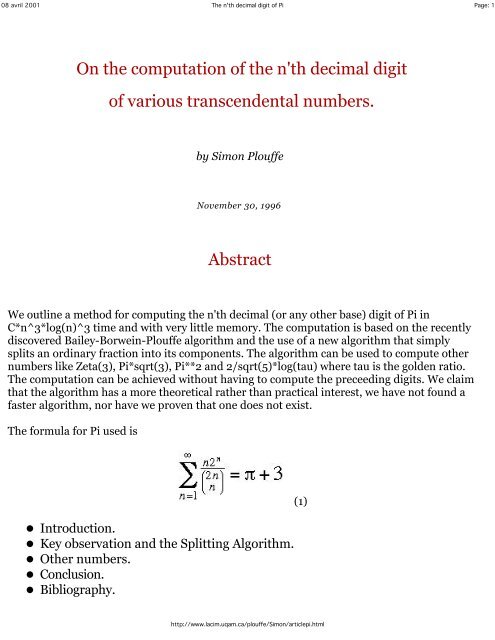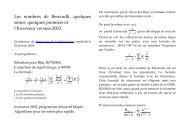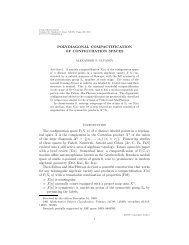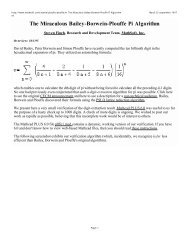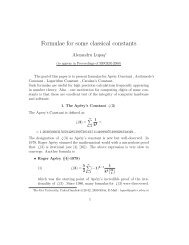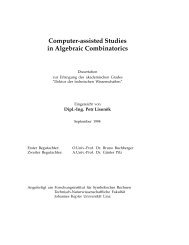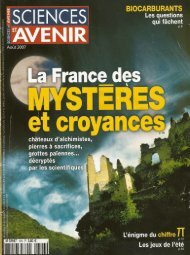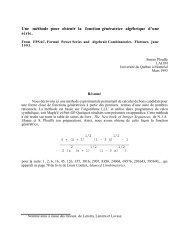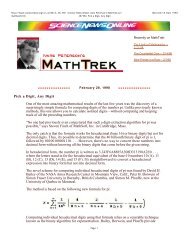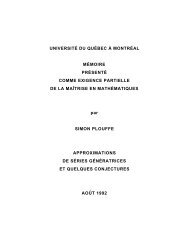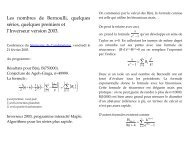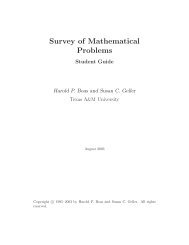Decimal Digit of Pi 1996 - Simon Plouffe
Decimal Digit of Pi 1996 - Simon Plouffe
Decimal Digit of Pi 1996 - Simon Plouffe
Create successful ePaper yourself
Turn your PDF publications into a flip-book with our unique Google optimized e-Paper software.
08 avril 2001 The n'th decimal digit <strong>of</strong> <strong>Pi</strong> Page: 1<br />
On the computation <strong>of</strong> the n'th decimal digit<br />
<strong>of</strong> various transcendental numbers.<br />
by <strong>Simon</strong> <strong>Plouffe</strong><br />
November 30, <strong>1996</strong><br />
Abstract<br />
We outline a method for computing the n'th decimal (or any other base) digit <strong>of</strong> <strong>Pi</strong> in<br />
C*n^3*log(n)^3 time and with very little memory. The computation is based on the recently<br />
discovered Bailey-Borwein-<strong>Plouffe</strong> algorithm and the use <strong>of</strong> a new algorithm that simply<br />
splits an ordinary fraction into its components. The algorithm can be used to compute other<br />
numbers like Zeta(3), <strong>Pi</strong>*sqrt(3), <strong>Pi</strong>**2 and 2/sqrt(5)*log(tau) where tau is the golden ratio.<br />
The computation can be achieved without having to compute the preceeding digits. We claim<br />
that the algorithm has a more theoretical rather than practical interest, we have not found a<br />
faster algorithm, nor have we proven that one does not exist.<br />
The formula for <strong>Pi</strong> used is<br />
Introduction.<br />
Key observation and the Splitting Algorithm.<br />
Other numbers.<br />
Conclusion.<br />
Bibliography.<br />
(1)<br />
http://www.lacim.uqam.ca/plouffe/<strong>Simon</strong>/articlepi.html
08 avril 2001 The n'th decimal digit <strong>of</strong> <strong>Pi</strong> Page: 2<br />
Introduction<br />
The computation <strong>of</strong> the n'th digit <strong>of</strong> irrational or transcendental numbers was considered<br />
either impossible or as difficult to compute as the number itself. Last year (1995) [BBP], have<br />
found a new way <strong>of</strong> computing the n'th binary digit <strong>of</strong> various constants like <strong>Pi</strong> and log(2). An<br />
intensive computer search was then carried out to find if that algorithm could be used to<br />
compute a number in an arbitrary base. We present here a way <strong>of</strong> computing the n'th decimal<br />
digit <strong>of</strong> <strong>Pi</strong> (or any other base) by using more time than the [BBP] algorithm but still with very<br />
little memory.<br />
Key observation and formula<br />
The observation is that a fraction 1/(a*b) can be split into k1/a + k2/b by using the continued<br />
fraction algorithm <strong>of</strong> a/b. Here a and b are two prime powers. This is equivalent to having to<br />
solve a diophantine equation for k1 and k2 - it is always possible to do so if (a,b) = 1 , see<br />
[HW] if they have no common factor. If we have more than 2 prime factors then it can be<br />
done by doing 2 at the time and then using the result to combine with the third element. This<br />
way an arbitrary big integer M can be split into small elements. If we impose the conditions<br />
on M <strong>of</strong> having only small factors (meaning that the biggest prime power size is <strong>of</strong> the order<br />
<strong>of</strong> a computer word), then an arbitrary M can be represented. If this is true then a number <strong>of</strong><br />
known series and numbers can then be evaluated. For example the expression 1/C(2*n,n),<br />
the central binomials satisfies that : the prime powers <strong>of</strong> this number are small when n is big.<br />
Example:<br />
1/binomial(100,50) = 1/100891344545564193334812497256 =<br />
1<br />
-------------------------------------------------------<br />
3 4<br />
2 * 3 *11*13*17*19*29*31*53*59*61*67*71*73*79*83*89*97<br />
Now if we take 2 elements at the time and solve the simple diophantine equation and proceed<br />
this way<br />
http://www.lacim.uqam.ca/plouffe/<strong>Simon</strong>/articlepi.html
08 avril 2001 The n'th decimal digit <strong>of</strong> <strong>Pi</strong> Page: 3<br />
1) 1/(a*b) = k1/a + k2/b<br />
2) (k1/a + k2/b)/c = m1/a + m2/b + m3/c<br />
3) we proceed with the next element.<br />
At each step the constants k1 and k2 are determined by simply expanding a/b into a<br />
continued fraction and keeping the 'before last' continuant, later m1, m2 and m3 are<br />
determined the same way.<br />
having finished with that number we quickly arrive at a number which is (modulo 1) the same<br />
number but represented as a sum <strong>of</strong> only small fractions.<br />
So, 1/100891344545564193334812497256 =<br />
61 11 25 26 23 41 29<br />
-3/8 - ---- -1/11 - ---- - 4/17 -9/19 - ---- - ---- + ---- + ---- + ----<br />
81 13 29 31 53 59 61<br />
37 33 19 36 13 88<br />
+ ---- + ---- + ---- + ---- + 7/83 + ---- + ---- .<br />
67 71 73 79 89 97<br />
The time taken to compute this expression is log(n)*n**2, log(n) being the time spent to<br />
compute with the euclidian algorithm on each number. We did not take into account the time<br />
spent on finding what is the next prime in the expression simply because we can consider (at<br />
least for the moment) that the applicability <strong>of</strong> the algorithm is a few thousands digits and so<br />
the time to compute a prime is really a matter <strong>of</strong> a few seconds in that range for the whole<br />
process. Since we know by advance what is the maximal prime there could be in C(2*n,n)<br />
then we can do it with a greedy algorithm that pulls out the factors until we reach 2*n, and<br />
this can be done without having to compute the actual number which would obviously not fit<br />
into a small space. It can be part <strong>of</strong> the loop without having to store any number apart from<br />
the current n. For any p in binomial(2*n,n) the maximal exponent is (as Robert Israel pointed<br />
out).<br />
http://www.lacim.uqam.ca/plouffe/<strong>Simon</strong>/articlepi.html
08 avril 2001 The n'th decimal digit <strong>of</strong> <strong>Pi</strong> Page: 4<br />
Equivalently, for p = 2 it gives the number <strong>of</strong> '1' in the binary expansion <strong>of</strong> n, for p = 3 there is<br />
another clue with the ternary expansion <strong>of</strong> the number and the number <strong>of</strong> times the pattern<br />
'12' appears.<br />
Now looking at the sum(1/C(2*n,n),n=1..infinity), we can say that the series is 'essentially'<br />
<strong>Pi</strong>*sqrt(3) since it differs only by 4/9*<strong>Pi</strong>*sqrt(3) + 1/3, since these are 2 small rationals we<br />
can use BBP algorithm to carry the computation to an arbitrary position in almost no time.<br />
Having n/C(2*n,n) instead <strong>of</strong> (1) only simplifies the process.<br />
To compute the final result <strong>of</strong> each term we need only few memory elements,<br />
1 for the partial sum so far. (evaluated later with the BBP algorithm).<br />
4 for the current fractions k1/a and k2/b.<br />
2 for the next element to be evaluated : 1/c.<br />
1 for n itself.<br />
So with as little as 8 memory elements the sum for each term <strong>of</strong> (1) can be carried out a<br />
without having to store any number greater than a computer word in log(n) time, adding this<br />
for each element the total cost for (1) is then n^3*log(n).<br />
The next thing we have to consider is that , if we have an arbitrary large M and if M has only<br />
small factors then 1/M can be computed. First, we need to represent 1/M as<br />
Sum(a(i)/p(i)**(j),i=1..k) (2) where p(i)^(j) is a prime power and a(i) is smaller than p(i)^(j).<br />
If we have 2^n/M then by using the binary method on each element <strong>of</strong> the representation <strong>of</strong><br />
1/M with (2) is possible in log(n) time. Again if we don't want to store the elements <strong>of</strong> (2) in<br />
memory we can do it as we do the computation <strong>of</strong> the first part at each step. In this algorithm<br />
we can either store the powers <strong>of</strong> 2 to do the binary method or not. There is variety <strong>of</strong> ways<br />
to do it, we refer to [Knuth vol. 2] for explanations.<br />
This step is important, essentially once we can represent 1/(a*b) by splitting them then to<br />
multiply by 2^n only adds log(n) steps for each element and it can be done in arbitrary base<br />
since we have the actual fraction for each element <strong>of</strong> (2). It only pushes the decimal (or the<br />
the decimal point <strong>of</strong> the base chosen), further. At any moment only one element in the<br />
expansion <strong>of</strong> 1/M is considered with the current fraction, that same fraction can be<br />
represented in base 10 at anytime if we want the decimal expansion at that point. For this<br />
reason multiplying the current fraction by 2^n involves only small numbers and fractions.<br />
Once this is done, the total cost becomes n^3*log(n)^2. This cost is for the computation <strong>of</strong><br />
the k'th partial sum <strong>of</strong><br />
http://www.lacim.uqam.ca/plouffe/<strong>Simon</strong>/articlepi.html
08 avril 2001 The n'th decimal digit <strong>of</strong> <strong>Pi</strong> Page: 5<br />
If we want at each step to compute (the final n'th digit) then we need log(n) steps to do it. It<br />
can be done in any base chosen in advance, in BBP the computation could be done in base 2<br />
but here we have the actual explicit fraction which is independant <strong>of</strong> the base. This is where<br />
we actually compute the decimal expansion <strong>of</strong> the final fraction <strong>of</strong> the process.<br />
So finally the n'th digit <strong>of</strong> <strong>Pi</strong> can be computed in C*n**3*log(n)**3 steps.<br />
Other Numbers.<br />
By looking at the plethora <strong>of</strong> formulas <strong>of</strong> the same type as (1) or (3) we see that [PIagm],<br />
[RamI and IV] the numbers <strong>Pi</strong>*sqrt(3) <strong>Pi</strong>, <strong>Pi</strong>**3, Zeta(3) and even powers <strong>of</strong> <strong>Pi</strong> can be<br />
computed as well. The condition we need to enseure is :<br />
if any term <strong>of</strong> a series can be split into small fractions <strong>of</strong> size no greater than that <strong>of</strong> a<br />
computer word, then it is part <strong>of</strong> that class. This includes series <strong>of</strong> the type :<br />
where c is an integer, P(n) a polynomial and C(mn,n) is a near central binomial coefficient.<br />
This class <strong>of</strong> series contains many numbers that are not yet identified in terms <strong>of</strong> known<br />
constants and conversely the known constants that are <strong>of</strong> similar nature like Zeta(5) have not<br />
yet been identified as members <strong>of</strong> the class. The process <strong>of</strong> identifying a series as being<br />
expressed in terms <strong>of</strong> known constants and the exact reverse process is what the Inverse<br />
Symbolic Calculator tries to do.<br />
The number e or exp(1) which is sum(1/n!,n=0..infinity) does not satisfies our condition<br />
because 1/n! eventually contains high powers <strong>of</strong> 2, therefore cannot be computed to the n'th<br />
digit using our algorithm. The factorisation <strong>of</strong> 1/n! has high powers <strong>of</strong> small primes, the<br />
highest is 2**k and k is nearly the size <strong>of</strong> n. For this particular number only a very few series<br />
are known and appear to be only a variation on that first one.<br />
Others like gamma or Catalan do not seem to have a proper series representation and<br />
computer search using Bailey's PSLQ or LLL with MapleV and Pari-Gp gave no answer to this.<br />
Algebraic numbers like sqrt(2) have not been yet been fully investigated and we still do not<br />
know if those would fall into this category.<br />
http://www.lacim.uqam.ca/plouffe/<strong>Simon</strong>/articlepi.html
08 avril 2001 The n'th decimal digit <strong>of</strong> <strong>Pi</strong> Page: 6<br />
Conclusions<br />
There are many, but first and foremost we cannot resist thinking at William Shanks who did<br />
the computation <strong>of</strong> <strong>Pi</strong> by hand in 1853 - if he would had known this algorithm, he would have<br />
certainly tried it before spending 20 years <strong>of</strong> his life computing <strong>Pi</strong> (half <strong>of</strong> it on a mistake).<br />
Secondly, the algorithm shown here is theoretical and not practical. We do not know if there<br />
is a way to improve it, and if so then it is reasonable to think that it could then be used to<br />
check long computations like the one that Yasumasa Kanada conducted last year for the<br />
computation <strong>of</strong> <strong>Pi</strong> to 6.4 billion digits. There could be a way to speed the algorithm to make it<br />
an efficient algorithm.<br />
Thirdly, so far there are 2 classes <strong>of</strong> numbers that can be computed to the n'th digit : 1) the<br />
SC(2) class as in the [BBP] algorithm which includes various polylogarithms. 2) this new class<br />
<strong>of</strong> numbers. Now what's next , so<br />
far we do not know wheter, for example, series whose general term is H(n)/2**n (where H(n)<br />
is the n'th harmonic number) whcich fall into the first class, can be extended. We think that<br />
this new approach is only the tip <strong>of</strong> the iceberg.<br />
Finally, it is interesting to observe that we can then compute <strong>Pi</strong> to the 10000'th digit without<br />
having to store (hardly) any array or matrix, so it can be computed using a small pocket<br />
calculator. We also note that, in some way we have a way to produce the digits <strong>of</strong> <strong>Pi</strong> without<br />
using memory, this means that the number is compressible , if we consider that we could use<br />
the algorithm to produce a few thousands digits <strong>of</strong> the number. We think that other numbers<br />
are yet to come and that there is a possibility () <strong>of</strong> having a direct formula for the n'th digit<br />
(in any base) <strong>of</strong> a naturally occuring constant like log(2).<br />
Acknowledgments.<br />
We wish to thanks, Robert Israel (Univ. British Columbia) , David H. Bailey (NASA Ames)<br />
and Peter B. Borwein (<strong>Simon</strong> Fraser Univ.) for their useful discussions.<br />
Bibliography (partial)<br />
David H. Bailey, Peter B. Borwein and <strong>Simon</strong> <strong>Plouffe</strong>, On The Rapid Computation <strong>of</strong><br />
Various Polylogarithmic Constants , april 1997 in Mathematics <strong>of</strong> Computation.<br />
Bruce C. Berndt, Ramanujan Notebooks vols. I to IV. Springer Verlag, New York.<br />
<strong>Pi</strong> and the AGM, by Jonathan M. Borwein and Peter B. Borwein, A Study in Analytic<br />
Number Theory and Computational Complexity, Wiley, N.Y., 1987.<br />
David H. Bailey and <strong>Simon</strong> <strong>Plouffe</strong>, Recognizing Numerical Constants , preprint 1995.<br />
Robert Israel at University <strong>of</strong> British Columbia, personal communication.<br />
M. Abramowitz and I. Stegun, Handbook <strong>of</strong> Mathematical Functions , Dover, New<br />
http://www.lacim.uqam.ca/plouffe/<strong>Simon</strong>/articlepi.html
08 avril 2001 The n'th decimal digit <strong>of</strong> <strong>Pi</strong> Page: 7<br />
York, 1964.<br />
G. H. Hardy and E. M. Wright, An Introduction to the Theory <strong>of</strong> Numbers 5e, Oxford<br />
University Press, 1979.<br />
W. Shanks, Contributions to Mathematics Comprising Chiefly <strong>of</strong> the Rectification <strong>of</strong><br />
the Circle to 607 Places <strong>of</strong> <strong>Decimal</strong>s, G. Bell, London, 1853.<br />
D.E. Knuth, The Art <strong>of</strong> Computer Programming , Vol. 2: Seminumerical Algorithms,<br />
Addison-Wesley, Reading, MA, 1981.<br />
http://www.lacim.uqam.ca/plouffe/<strong>Simon</strong>/articlepi.html


